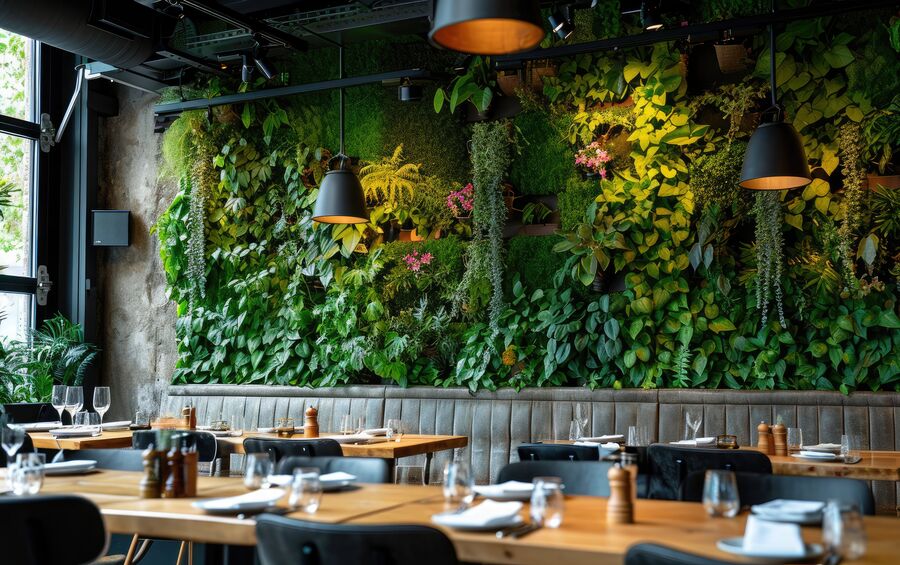
Restaurant sustainability is a set of practices that food businesses implement to reduce their environmental impact. It has been a focus of the restaurant industry for over a decade now. But as costs of goods and operations rise, supply chains struggle, and consumers become more environmentally conscious, sustainability in restaurants has become even more popular.
Key Takeaways:
- There are several restaurant sustainability categories: energy sourcing, building design, supply sourcing, operational updates, and staff support.
- Start small and build your sustainability efforts over time.
- Individual, certified sustainable products may cost more, but sustainability efforts reduce other costs (like energy costs).
Understanding Restaurant Sustainability
Restaurant sustainability involves menu design, supply sourcing, and operational changes that reduce a restaurant’s environmental impact. Choosing to sell only seafood that is sustainably caught is a popular restaurant sustainability strategy. Reducing energy consumption or obtaining energy from sustainable sources is another example of restaurant sustainability.
Generally, restaurant sustainability strategies fall into five major categories:
- Energy sourcing and use: Restaurants use a lot of energy and a lot of water, so switching to solar power or purchasing high-efficiency dishwashers can have a big impact.
- Building design: Organizations like Leadership in Energy and Environmental Design (LEED) provide benchmarks for green buildings that are efficient and sustainably built.
- Supply sourcing: Choosing supplies that are certified by sustainability authorities is one of the easiest ways to boost restaurant sustainability.
- Operational updates: Updating your plating or recycling systems can reduce food waste, adding more plant-based items to your menu, or using software that identifies more opportunities for efficiency are all possible operational updates.
- Staff support: Increasingly, restaurants tout the ways they support their employees’ well-being and personal development as a form of “staff sustainability.”
You don’t need to achieve sustainability in all of these areas, especially not all at once. You can start with one category and go all in, or simply integrate a few strategies that make sense for your business. Then, make more updates to your operation as your business grows.
Benefits of Restaurant Sustainability
Moving toward a more sustainable restaurant can sound like a lot of work, but it can be worth it. Making your restaurant more sustainable can have a lot of benefits, including:
Shortened Supply Chains
A major restaurant sustainability strategy is buying locally-made products whenever possible. Local products have much shorter supply chains, which may reduce fuel costs and keep your restaurant supplied when longer supply chains experience delays or failures. Shortened supply chains also have a lower carbon footprint and can reduce fuel-based delivery costs.
Attracts Customers
Customers are cost-conscious, but a majority are also interested in sustainability. And most are willing to pay over 10% more—up to 20% on average—for sustainable foods.
A 2022 report by Deliverect also found that:
- 56% of the US dining public wants restaurants to be more transparent about eco-friendly initiatives.
- 54% of diners prefer to order from restaurants that do not use excess takeout and delivery packaging.
- 73% of consumers support reasonable portion sizes to reduce food waste.
So, your sustainability measures can also be fodder for your marketing efforts and attract like-minded customers.
Reduced Energy Costs
Studies by various restaurant organizations have found that efficiency-directed restaurant sustainability measures like reducing food waste and conserving water and electricity can pay dividends.
One 2019 study found that every $1 a restaurant spent toward food waste reduction programs, saved it $7 in operating costs. According to research by ENERGY STAR, designing a commercial kitchen with all ENERGY STAR certified cooking and refrigeration equipment can save a restaurant around $4,500 annually.
Restaurant Sustainability Challenges
Making sustainable choices for your restaurant business can be challenging. Certified sustainable products usually cost more than conventional products. And you’ll need to do a little more legwork to source them.
Before you dive into restaurant sustainability, you should prepare for:
Limited Selection
Seeking out sustainable products to resell will limit the number of products you choose from—whether that’s produce, proteins, or paper products. There may be limited amounts available, and you may not be able to find the product you prefer all the time.
You can build flexibility into your recipes and supply guides. Add alternative substitutions to your recipe cards and event guidelines, including product numbers and alternative suppliers. As you become fluent with the products available at different times of the year, you can create seasonally adjusted recipes and product guides.
Higher Product Costs
Certified sustainable products may cost more than their non-sustainable competitors. These price differences typically cover the costs associated with obtaining certifications from third-party entities. Not all sustainable products cost more—especially if you rely on local suppliers—but items like compostable takeout containers can cost 40% to 50% more than non-compostable containers.
You may be able to pass on some of these higher costs directly to customers—many are willing to pay up to 20% more to support sustainability. You can also educate staff and customers about what makes some higher-priced products worth the cost.
Restaurant sustainability is a massive project. As you read through this list, it can begin to feel impossible. So, start small. You don’t need to make every change, and you don’t need to make a million changes at once.
Start with one sustainability initiative, like sourcing a local farm for all of your tomatoes, or upgrading your dishwasher to one that uses less water. Once that change makes an impact on your business—in about six to eight months—choose another sustainability strategy.
Source Sustainable Seafood
Sourcing sustainable seafood is one of the first steps most restaurants take toward restaurant sustainability because it is one of the easiest to implement.
For more than 24 years, the Monterey Bay Aquarium has issued Seafood Watch lists, detailing which types of seafood are sustainably caught and which types of fish should be avoided. They publish annual guides for multiple US regions and also offer a smartphone app to help you choose sustainable seafood to add to your menu.
The Monterey Bay Aquarium Seafood Watch lists make it easy to choose sustainable seafood. (Source: Monterey Bay Aquarium)
All you need to do is order seafood that fits the description from this list and avoid seafood not categorized as sustainable. Print a guide to keep in your pocket, post it in your back office, or download the app and then place orders with your seafood vendors that match the descriptions. The Monterey Bay Aquarium is also very good about sending you materials for staff training and customer education if you need to get staff and customers on board with your choices.
What makes seafood sustainable? Many factors make seafood sustainable, from the way the fish is caught (farmed, trawled, long line caught), where it is caught, or the overall population of the fish at a given time. Visit the Seafood Watch website for more information.
Source Sustainable Meats
Meats are a little more complicated to source sustainably, as there is no organization creating a centralized list (like the Monterey Bay Aquarium does for seafood). But as with seafood, many characteristics can make meat sustainable, from the way the animals are raised to the resources used to raise them. Generally, sustainable meats come from animals that are raised humanely and with methods that reduce environmental impact.
In vendor product lists, these terms can identify sustainably raised meats:
- Grass-fed: To qualify as “grass-fed” by the USDA, animals must be fed grass for their entire lifespan.
- Pasture-raised: Pasture-raised animals have access to the outdoors for some or part of their lives; they are not confined indoors.
- Certified organic: USDA-certified organic meats cannot be genetically modified, and must be raised in a way that preserves biodiversity and conserves natural resources.
- Animal Welfare Certified: The Global Animal Partnership (G.A.P.) audits farms and certifies that animals are raised humanely.
- Certified Carbon Neutral: This certification is given by the global group Climate Impact Partners. It can apply to companies, products, or events.
Meats with any of these certifications more than likely fall in the “sustainable” category. You can be even more confident in the sustainability of meats with a combination of these certifications.
Certification labels like the ones seen here on TruBeef Organic’s website indicate sustainably raised meat. (Source: TruBeef Organic)
You can also source sustainable meats more manually. Visit local farms that raise livestock, see their practices and operations, and find out if they can supply enough meat for your needs. Many small, local farms raise animals sustainably but lack the time and resources to get official certifications. If a local farm doesn’t produce enough meat to support all of your meat sales, they might be able to supply you with enough meat for a single menu item or a weekly special.
Buy Local Produce
You can easily source local produce by visiting farmer’s markets or contacting the farm directly. Once you’ve found a farm, you have two main strategies: build menu items around seasonally available crops or ask a farmer to grow products you already use.
With either strategy, it’s a good idea to contact farmers before the growing season starts; late January is good in most locations. Find out what crops they grow well and build a menu around those, or bring a menu and ask them which ingredients they feel confident growing for you.
I know many chefs who have brought hard-to-find vegetables directly to farmers who grow the crop and sell them directly to the restaurant. This type of farm relationship is a secret weapon of most high-profile chefs in the country. All it takes to do it yourself is a relationship with a nearby farmer.
Grow Your Own Produce
Some restaurants grow their own produce. With staffing shortages and staff burnout, this can sound impossible, but you can start small with a window box of herbs. If you have a rooftop or parking lot, you can convert those areas into raised beds or convert smaller indoor spaces into hydroponic growing areas.
The Bayless Gardens on the rooftop of Chicago restaurant Xoco supplies produce for several Rick Bayless restaurants. (Source: Rickbayless.com)
Update Your Energy Sources
If you own your restaurant location, you might consider adding solar panels to your rooftop. Or, inquire with your electric provider about any renewable energy packages they offer. Some utility companies offer tiers of wind- or solar-derived energy, often called “green power” or “clean power” packages. You might also explore induction cooktop options rather than gas in your kitchens. This will be controversial for some chefs, I know, but you might be able to convert a stalwart gas fan by mentioning how induction cooking improves indoor air quality compared to gas cooktops.
Reduce Energy Use
Reducing energy consumption is another great restaurant sustainability move. It works hand in hand with converting to renewable energy or is an impactful move if you can’t switch your energy sources.
Identify places where you can switch off lights or appliances when they are not in use. Remember to check outdoor lights; are you consistently turning them off during the daytime? Consider areas where several lights are wired to the same switch. Could you bring in an electrician to split the lights onto two or more switches so you have more flexibility?
You can also set a standard for interior temperature. Set and lock your thermostats to a predetermined level. And, invest in some soft, washable wraps for guests who complain of chills and drafts.
Some other ways to reduce your restaurant’s energy use include:
- Switching to LED Lights: LED lights use up to 80% less energy than incandescent and heat up less than fluorescent bulbs.
- Upgrading kitchen appliances: Upgrading your refrigeration equipment, ovens, steam tables, ovens, and other appliances to more efficient models can save you energy (and money) in the long run. Modern equipment operates much more efficiently than older models, reducing your energy consumption.
- Upgrading larger systems: Modernizing large equipment like heaters, air conditioners, hot water heaters, and hand dryers can have an even larger impact on your sustainability initiatives and energy bills.
Reduce Water Consumption
Restaurants use a lot of water—from 3,000 to 7,000 gallons per day—depending on the restaurant type and the volume of dishes washed. Switching to more efficient dishwashers, ice machines, and coffee makers can reduce the water used in those appliances by up to 50%, which can also save you around $3,300 in water costs every year.
Adding dual flush toilets to your staff and customer restrooms can reduce restroom water use by around 20%, and you can likely find rebates and tax incentives to reduce the costs of a retrofit.
Get Your Green Baseline
The Green Restaurant Association (GRA) has been educating restauranteurs and the dining public about restaurant sustainability since 1990. This organization has a simple online survey you can complete to learn your current level of “green-ness” and identify areas where you can immediately make sustainable switches.
Update Disposables & Takeout Packaging
It has never been easier to find compostable takeout containers and other items made from post-consumer or other eco-friendly materials. Mainline distributors like Sysco, US Foods, and Webstaurant Store carry a wide variety of eco-friendly packaging materials.
These straws, made from hay, are more sustainable than plastic straws, more robust than paper straws, and are compliant with plastic straw bans. (Source: Webstaurant Store)
Disposable items can go beyond takeout containers. Consider on-location disposable items like straws, napkins, paper towels, and other products. In some cases, you might be able to switch to reusable versions (metal and glass straws are popular add-on items in areas with straw bans) or simply find a sustainable option that is compostable (like hay or paper straws).
Start Composting
Speaking of composting—if you don’t get compost, now is a good time to start. Check with your waste hauler and inquire about composting options. In cities like San Francisco that have passed composting laws, you won’t have any trouble. However, in my experience, you may need to forge your own path in smaller markets where composting is not well-established.
If you can’t find a local composting company to take your compostable food and paper products, reach out to your local farming community (local organic farmers’ associations are a good place to start). You’ll likely find farmers who are eager to take food scraps for pigs and other livestock and vegetable growers and gardeners interested in your coffee grounds. This strategy gives the added bonus of bolstering your network of farmers who can supply your restaurant with meat or vegetables and haul away some food scraps when they deliver your order.
Recycle Cooking Oil
Almost every waste hauler also runs a standard glass and cardboard recycling program; that’s nothing new. But serious recyclers recycle their used cooking oil. Some nationwide brands like DAR PRO Solutions operate used oil collection services in most states. You can also find regional companies in more rural locations. If you have a lot of cooking oil to dispose of and are struggling to find a service to take it, ask the company that cleans your grease traps or look for bio-diesel manufacturers in your area.
A major brand like DAR PRO operates oil collection services in more than 40 states. (Source: DAR PRO Solutions)
Reuse What You Can
Beyond recycling and using sustainable packaging, you can also find creative ways to reuse containers. Glass bottles of all sizes can be cleaned, sanitized, and reused as containers for water, sauces, or beverages. They can also become vases and vessels for decor. Develop the habit of considering what other uses an item may have before you toss it in the garbage. Turn damaged aprons and tablecloths into cleaning cloths; stained cushions can be re-upholstered.
Recirclable is a Boston-based business that supplies reusable takeout containers to participating restaurants. (Source: Recirclable)
If you have the dishwashing bandwidth, try offering reusable takeout containers. This might sound like a fast way to lose money. But you may be surprised at how willing eco-conscious customers are to keep a sustainable program going. If you’re really concerned, though, you can always charge a deposit or offer reusable containers to only known customers—like regulars or loyalty members.
Use Sustainable Employment Practices
Many restaurants are expanding their definition of sustainability to include general sustainable business practices. This usually means making choices that support their employees and encourage longevity in their team.
These types of employee sustainability policies can be paying an equitable wage to all employees throughout your restaurant and offering profit sharing, health benefits, sick leave, paid time off, or other perks. Customers like to know that workers are happy in the businesses they patronize. So, sustainable employment policies are as marketable as touting the network of local farms your restaurant supports.
Ask for Help
There are many ways to create sustainable solutions in restaurants. Many independent restaurant teams are struggling with the same issues you are. So, don’t feel like you need to invent every solution yourself. Ask other independent restaurant owners and managers what solutions work for them, or ask them to test new ideas alongside you.
Outside the restaurant industry, connect with local nonprofits that work on sustainability and eco-conscious initiatives. They may have fresh ideas and resources to help you resolve some of your pain points. Nonprofits may also have grants available to help defray the costs of making some sustainable switches.
Sustainable Restaurant Examples
There are many great examples of sustainable restaurant programs. I’ve listed a few of my favorites to show you what is possible with a little creative thinking and community collaboration.
The Sustainable Restaurant Building
Print Works Bistro, a restaurant inside the Proximity Hotel in Greensboro, North Carolina, was the first restaurant to earn a Platinum LEED rating from the US Green Building Council (USGBC). This employee-owned hospitality business earned this rating by reducing energy use by 41% and water use by 33% during construction.
Even the Print Works Bistro bar earns sustainability points; it is constructed of salvaged walnut trees felled by sickness or storm. (Source: Print Works Bistro)
This AAA five-diamond rated hospitality business also earned this rating by:
- Installing 100 rooftop solar panels to heat water
- Recycling 87% of the construction debris (1,535 tons)
- Using over 20% recycled content during construction and recycling 1,535 tons of construction debris
- Restoring 700 feet of an adjacent stream during construction
- Installing regenerative drive elevators, which generate electricity on the descent for the ascent
- Relying on natural day-light for 97% of the occupied space
- Running restaurant refrigeration equipment off geothermal (rather than water-cooled) technology
The Reusable Cup Experiment
Between November 2022 and October 2023, the San Francisco Environment Department and the Clean Water Fund’s “ReThink Disposable” program teamed up to test a pilot project sending reusable cups to three live music venues (The Warfield, The Fillmore, and August Hall). The project connected the venues with cup providers r.World and TURN, to replace single-use plastic cups with reusable cups that patrons placed in onsite return bins.
In a single year, switching to reusable cups at San Francisco’s August Hall could save nearly $30,000, not including reduced waste hauling fees from the nearly 5,000 pounds of plastic they no longer throw away. (Source: ReThink)
In the study period, all three venues experienced lower costs for sourcing reusable cups versus continually repurchasing disposable cups. And one venue, The Warfield, which charged a 3% sustainability fee to offset the initial purchase of the reusable cups projected a $33,000 profit from using the cups.
The Zero Waste Restaurant
London restaurant Silo wrote the playbook for a zero-waste restaurant operation. Chef-owner Doug McMaster and his business partners have been thinking about a “bin-less” restaurant since 2011.
Silo’s fermentation program is a key part of their zero waste operation; reducing the amount of food waste they produce by extending the shelf life of ingredients. (Source: Silo London)
So, the Silo team has thought through every detail. Here are some key ideas from their operation to inspire your restaurant:
- Sustainable furniture: Silo’s tables are made of former food packaging, light shades are made from mycelium, and floors are made of compostable cork.
- Adopt “pre-industrial” deliveries: Silo’s suppliers deliver products on pails, crates, and other returnable or reusable vessels.
- Make raw materials: Silo brews beer, mills flour, churns butter, and rolls their own oats, so they don’t have those packaging materials to deal with.
- Ferment rather than discard: Silo ferments foods before they spoil to extend their shelf life, and also experiments with fermenting commonly discarded items like cheese rinds.
- Work directly with farmers: By sourcing directly from farmers, Silo avoids the added packaging that middleman wholesalers and distributors may add to preserve and package products.
The biggest thing you’ll notice about Silo is how the team approaches the idea of waste as a puzzle to solve. And they seem eager to approach their menu, decor, and service first from the perspective of removing waste from the equation. If that idea doesn’t energize you, you’ll be better suited for a smaller-scale sustainability process. Even if you aren’t ready to grow lampshades out of mycelium and churn your own butter, it’s nice to know what is possible.
Frequently Asked Questions (FAQs)
Restaurant sustainability is a big topic. These are the most common questions I hear from restaurant owners and managers considering eco-friendly restaurant strategies.
Restaurant sustainability is a catch-all term for any number of eco-conscious practices restaurants adopt to reduce their environmental impact. Restaurant sustainability practices can include anything from construction choices like choosing energy-efficient appliances to replacing plastic straws with paper ones.
Restaurants can promote food sustainability by buying local products whenever possible and making every effort to use ingredients before they spoil. This can include strategies like partnering with a local farm to grow salad greens or creating a fermentation program to extend the shelf life of ingredients.
Sustainable restaurants can have any number of “green” certifications. Restaurants that rely on eco-friendly and regenerative construction strategies may be LEED-certified by the US Green Building Council. Restaurants that adopt sustainable practices from reducing food waste to eliminating chemical cleansers may be certified by the Green Restaurant Association.
You generally never have to wonder about whether a restaurant makes sustainable choices. Sustainability is such a strong marketing point that any sustainable restaurant will advertise the eco-friendly steps the business takes.
To be truly sustainable, any eco-conscious choices a restaurant makes must also either drive profit, reduce costs, or have a minimal cost impact. You can maximize the sustainability and efficiency of your restaurant operation by starting with a good baseline measurement of your restaurant’s energy use, food waste, and waste disposal costs before you make any changes.
Starting with an accurate baseline will help you see quickly which changes are the highest priority. You’ll also be able to see which changes are having a worthwhile impact early in your sustainability journey.
Bottom Line
Restaurant sustainability is an ongoing process. The great news is that there are a ton of great resources to help you figure out the best sustainable restaurant practices for your restaurant. Consumers are eager to support sustainable restaurant initiatives and are willing to pay (a little bit) more if that helps your restaurant make eco-conscious choices. Check in with local sustainability organizations, nearby farmers, and other restaurants to help support you in your sustainable restaurant plans.





